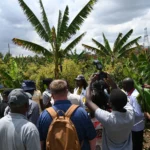By Ruth Keah

Growing up, Juma Mnyika loved watching monkeys jump up and down mangrove trees in his Ganahola village at Kenya’s coastal county of Mombasa.
However, these beautiful sceneries are only memories now for the 42-year-old, since most parts of the mangrove forest have been destroyed.
“The monkeys ran away due to the mangrove forest destruction. Now we only see one monkey in a month which comes into our homestead to look for food,” says Mnyika.
Mangroves are among the most productive marine ecosystems on earth, providing a unique habitat for many animal species. They provide habitats for birds, breeding grounds for many fish species as well as protection against storms, floods and erosion. Mangrove forests also act as important carbon sinks because they have higher amount of biomass compared to terrestrial tropical forest.
Sadly, mangroves are in danger of human destruction and their global distributions have been on the decline. Take the case of Tudor Creek in Mombasa, Kenya which has lost 80 per cent of its mangroves over the past 20 years.
However, Mnyika and his fellow bee farmers are now doing their best to restore and protect the endangered trees.
In a project Asali Mkoko, over 100 farmers along the Tudor creek earn a living by harvesting honey from the beehives and also use the bees as security for the mangrove forest.
“We started planting the mangroves, but noticed that people were still destroying them, so we deiced to install beehives along the Tudor creek to act as 24-hour security,” says Mnyika.
“The beehives have been very effective because when one decides to cut down a mangrove tree, the bees attack him/her; they are boxed shaped with half a foot size.”
He says that since 2010 when the project started, almost 90 per cent of mangrove destruction has stopped, and some of the birds, crabs, prawns and fish that had disappeared are returning.
Mnyika owns 12 beehives. They check on the hives at least once or twice in one and a half months and harvest the honey every four months. One hive produces up to 20kg of honey in a good season and eight kilos in a bad season.
“I have found a livelihood in the mangrove forest. We sell one kilo of honey at Sh1,200,” he says.
A non-governmental organisation Big Ship buys the harvested honey hence providing a ready market.
Agnes Mjeni from Madzombani Village, Mwakirunge in Mombasa County is a former logger. She used to cut down mangroves to use as firewood and charcoal.
“I was among the people who cut down trees and use them as firewood and the mangroves produce very good charcoal for cooking, I didn’t know its benefits and so I used to cut them down,’ she said.
As time went by, they saw the mangrove forest along the Tudor Creek which also covers their area was decreasing. More than 80 percent of mangroves were lost due to indiscriminate logging and even climate change. This loss spark plugged them to form Amani Jipange Peace Group. This has action led to them becoming beneficiaries of the beekeeping farming project with the help of the Big Ship Organisation.
The bees produce honey which they sell to sustain their families. At the same time, the bees protect the mangroves from loggers. Mjeni says the bees are cost effective compared to hiring of guards.
Ever since she started reaping the benefits of the mangrove Mjeni do not allow any person to cut down the trees and that is where as the group they had to find a permanent protector for the mangroves.
Mwinga Gonzi is the chairperson of the 20-member Amani Jipange Peace Group involved in beekeeping.
‘We started the group in 2012 to plant the mangrove to restore the forests but after realising that there was still deforestation, we engaged in beekeeping to protect the forest and also earn a living,’ he said adding that, ‘We came up with bees as a solution because many people fear bee sting and beside it gives us honey which we sell to get money.”
The group has 40 hives. Members look after them two or three times per week. They can harvest between three to five hives every three months. One hive produces up to 10kgs of honey. The mangrove honey popularly known as ‘Asali Mikoko’ sells for between Ksh.800 and Ksh.1000.
However, such community projects are not without challenges. The farmers led by Mnyika find it hard for the bees to find the right flowers to produce honey during the dry season. This reduces their harvest.
“Due to the prolonged dry season, this year I have only harvested honey once, and I only got 10kg,” he says.
Monitored wildlife populations – mammals, birds, amphibians, reptiles and fish – have seen a devastating 69 per cent drop on average since 1970, according to World Wide Fund for Nature (WWF) Living Planet Report (LPR) 2022. The report warns governments, businesses and the public to take transformative action to reverse the destruction of biodiversity.
Around the world, the report indicates that the main drivers of wildlife population decline are habitat degradation and loss, exploitation, introduction of invasive species, pollution, climate change and diseases.
World leaders meet at the UN Biodiversity Conference (CBD COP15) this December for a once-in-a-decade opportunity to course-correct for the sake of people and the planet. WWF is advocating for leaders to commit to a ‘Paris-style’ agreement capable of reversing biodiversity loss to secure a nature-positive world by 2030.
“The LPR report makes it clear that delivering a nature-positive future will not be possible without recognising and respecting the rights, governance, and conservation leadership of Indigenous Peoples and local communities around the world,” says Alice Ruhweza, Africa Regional Director, WWF-International.
Evelyn Omondi from Big Ship Organisation, a community empowerment organisation that focuses on implementation of local solutions on restoring and protecting the environment, says they decided to partner with the community and some former loggers to set up a mangrove bee farming project to protect the diminishing Tudor Creek mangrove forest.
“We train them on seedling establishment, bee keeping and monitoring of the beehives, and establish a market for the honey,” she says.
‘The farmers are normally trained for 5 days on how they can do beehive farming. After selling the mangrove seedlings, the money is being used to purchase the beehives for the farmers,” she added.
The different types of mangrove seedlings are often sold to visiting guests who together with the farmers plant them along the Tudor Creek.
‘We decided to bring together the former loggers to change their mindset against logging and teach them the importance of conserving mangroves,’ notes Ms Omondi.
So far, they have engaged more than 200 former loggers in the beekeeping project. The over 500 beehives are set up at various strategic points along the forest.
‘We organise meetings with the local communities and educate them on the benefits of mangrove conservation, after that we make an appeal to those who want to join the farmers, that’s how we recruit members,” she noted, adding that the recruitment and training exercise is normally done twice a year.
The group sells mangrove seedlings at Ksh100 each. From the sales, they buy beehives and give to farmers they have recruited. The farmers then plant the seedlings along the creek.
Their long-term plan is to make sure that each community member in the areas
they cover can get at least 10 beehives.
One beehive costs Kshs. 6,000. They are positioned in a manner that the farmers can access them with ease during both low and high tides. The farmers are the ones who position them without any assistance in a distance of 100 metres away from the neighbouring village.
They mostly place them where the Black mangrove Avicennia germinans type is found. This is because this type of mangrove has flowers which can attract bees.
According to Ms Omondi, the mangrove has many benefits in the ecosystem. There is a symbiotic relationship between the bees, the beekeepers, and the mangrove forest. The bees feed on the mangrove flowers, making highly desirable honey free from commercial additives.
One of the challenges they encounter is that most farmers have inadequate knowledge in bee keeping, hence they spend more time and resources on training them.
Despite the challenges, they have restored 67 hectares of mangroves along the Tudor Creek.
Experts estimate that mangroves in Kenya store between 600 and 1,500 tonnes of carbon per hectare. This means that the 3,371 hectares of mangroves in Mombasa County store an average of 3.94 million tonnes of carbon.
Editor’s Note: This story has been updated from the one published on October 31, 2022.








